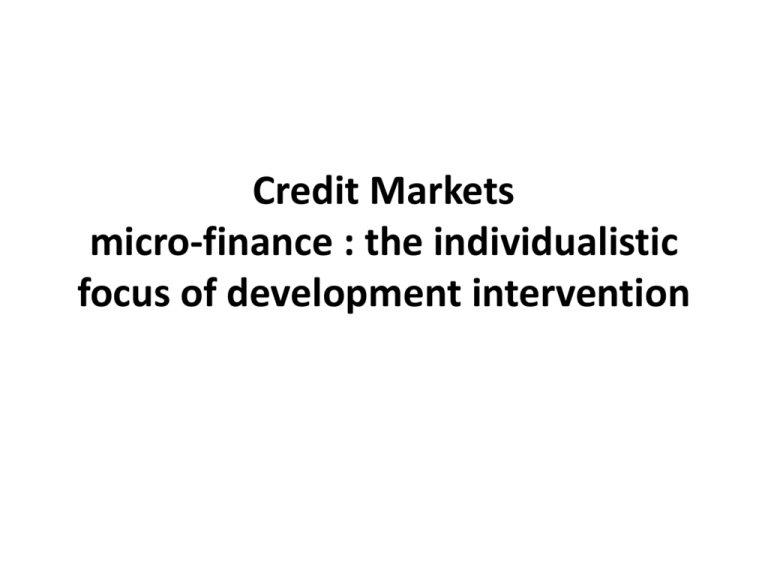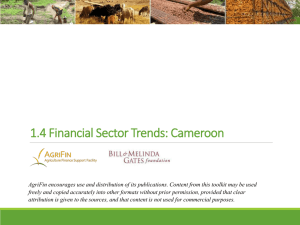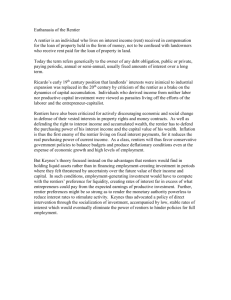RentCredit
advertisement

Credit Markets micro-finance : the individualistic focus of development intervention Micro-Credit and Rural Poverty: An Analysis of Empirical Evidence Pallavi Chavan and R. Ramakumar Economic and Political Weekly, Vol. 37, No. 10 (Mar. 9-15, 2002) • “This paper reviews empirical evidence on NGO-led micro-credit programmes in several developing countries, and compares them with state-led poverty alleviation schemes in India. The study shows that microcredit programmes have been able to bring about a marginal improvement in the beneficiaries' income. However, the beneficiaries have not gained much by way of technological improvements, given the emphasis on 'survival skill'. Also, in Bangladesh the practice of repayment of Grameen Bank loans by making fresh loans from moneylenders has resulted in the creation of 'debt cycles'.” LIMITS OF MICRO CREDIT FOR RURAL DEVELOPMENT: A CURSORY LOOK B. Mishra and Purusottam Nayak* Rural Indebtedness in North East India, Dibrugarh University, Dibrugarh, Assam, India, 2004 • Also on Grameen Bank, DFI: “Entrepreneurs who start micro enterprises typically lack assets, especially marketable ones to use as collateral for loans. … As far as screening was concerned, three methods were evolved to assess the borrowers’ credit worthiness. The most common was to lend to members of a group who were jointly and severally liable for the repayment of loans made to each member of the group. Screening was facilitated by self selected groups. This ensured that only people who the rest of the group took to be credit worthy were allowed in. Such groups have been euphemistically called ‘solidarity groups’ (Berenbach et al 1994, p.127). This was by far the common approach, although it did not necessarily attest to its efficacy. …almost all groups insisted on their borrowers saving money, at least initially. This was designed to provide evidence of financial management skills and to provide a small amount of collateral in some cases. …In attributing the cause of poverty to insufficient access to credit, micro finance evangelists obscure the generative mechanism behind much poverty - an unequal distribution of powers at the local, national and international level.” Understanding and Dealing with High Interest Rates on Microcredit A NOTE TO POLICY MAKERS IN THE ASIA AND PACIFIC REGION Nimal A. Fernando, East Asia Department, May 2006, Asian Development Bank • “The nominal interest rates charged by most MFIs in the region range from 30% to 70% a year (on a reducing- balance basis). The effective interest rates are even higher because of commissions and fees charged by MFIs. Other factors - such as the compulsory deposits for obtaining a loan, frequency of repayments, and the systems adopted to collect repayments - also raise the effective interest rates. High interest rates charged by MFIs have attracted criticism from government and opposition leaders in Bangladesh, Cambodia, India, Pakistan, and Sri Lanka. At a microcredit summit in Dhaka in 2004, the Minister of Finance for Bangladesh described microcredit interest rates in that country as ‘extortionate’. …Many policy makers question why microfinance interest rates remain high even when MFIs receive concessional funds to finance lending. Although microlenders receive loan funds at concessional rates, they must cost these funds at market rates when they make decisions about interest rates to ensure the sustainability of the institution's operations. ‘Charging prices high enough to cover costs is an essential practice for any business enterprise that intends to continue its operations beyond the short-term’.” Repayment Frequency and Default in Microfinance: Evidence From India Erica Field, Harvard University; Rohini Pande, Kennedy School of Government © 2008 by the European Economic Association, April-May 2008, Vol. 6, No. 2-3 • "In stark contrast to bank debt contracts, most micro-finance contracts require that repayments start nearly immediately after loan disbursement and occur weekly thereafter. Even though economic theory suggests that a more flexible repayment schedule would benefit clients and potentially improve their repayment capacity, micro-finance practitioners argue that the fiscal discipline imposed by frequent repayment is critical to preventing loan default. In this paper we use data from a field experiment which randomized client assignment to a weekly or monthly repayment schedule and find no significant effect of type of repayment schedule on client delinquency or default. Our findings suggest that, among micro-finance clients who are willing to borrow at either weekly or monthly repayment schedules, a more flexible schedule can significantly lower transaction costs without increasing client default." The Vulnerability of ‘Self-Help’: Women and Microfinance in South India K. Kalpana IDS [Institute of Development Studies, University of Sussex] WORKING PAPER 303, April 2008 • Self-help groups (SHGs) play a major role in providing microfinance in India. But they do not work alone. State institutions are also a big part of the microfinance landscape. They promote and finance SHGs, and also interact directly with them. How does this kind of ‘institutionalised coproduction’ in service delivery work in practice? • My research shows that the relationships are not symmetrical. When they seek access to bank credit, women’s groups are in a dependent relationship, and are subject to, and tarnished by, the institutional imperatives, systemic corruption and political compulsions that shape the behaviour of rural development bureaucracies and banks. The Vulnerability of ‘Self-Help’: Women and Microfinance in South India K. Kalpana IDS [Institute of Development Studies, University of Sussex] WORKING PAPER 303, April 2008 • Part of the problem lies in a legacy of bank staff mistrusting borrowers due to arrears from previous credit granted under a different set of public schemes. Banks still try to recover old loans, and sometimes grant new loans to womens’ SHGs conditional on repayments by their male relatives. Women consider the ways in which bank officials assess credit-worthiness of SHGs as sometimes being discriminatory and suggestive of caste-profiling. Since banks, as institutions, are not very sensitive to the realities of their SHG borrowers, the quality of the relationship often depends on the attitude of the bank’s branch-manager. Success in accessing loans is often contingent on how SHGs, bank staff, government officers and non-government organisations collude to subvert the official objective of the loan programme – enterprise-promotion. Manufacturing evidence about non-existent enterprises involves substantial costs and risks for SHGs. Providing financial services in rural India is now a profitable venture and is attracting private financing institutions, including transnational banks. My research suggests that we need to enquire further into the power dynamics that underlie relationships between the poor people using the financial services and their providers. 'Micro-credit improves cash flow but doesn't create wealth’ NGOs, banks and corporations have benefited from micro-credit at the cost of the poor, says development analyst Dr Sudhirendar Sharma http://infochangeindia.org/200510026116/Micro-credit/Backgrounder/-Micro-credit-improves-cash-flow-but-doesn-tcreate-wealth.html • Do the negative impacts of micro-credit outweigh the positive? • Simple cash flow or easy credit are the much-talked-about short-term gains, but in the long run, we will witness a cumulative debt trap, and the adverse consequences of moving away from primary production activities to supporting market interests. These long-term negative impacts outweigh the short-term positives. But who is interested when the dominant swing is in favour of micro-credit, and when each development worker is singing the micro-credit tune. The micro-credit ‘movement’ has eroded community feelings, systematically blunted peoples' political sharpness, and is side-tracking the critical question of livelihoods security. Put all of these together and one gets a picture of despair, tragically in the name of the poor. Loans for Arts Organisations, Catalonia • The Catalan Department of Creative Industries was under investigation for their calamity over the introduction of loans for arts organisations. • There is a link to three translated articles regarding the problems the Department was having getting the money back it distributed in the form of repayable credit / loans, and trying to reconceptualize the loans back into subsidies. • http://www.variant.org.uk/events/art+labour/CatalanLoan. pdf • The first, CICI Support and the Creative Industries, is an article written by the current director, in which he tries to explain the situation. He writes (roughly) : "We conceived the refundable contribution [credit / loans] system as a way to have financial participation in market driven cultural projects and, therefore, be subject to enterprise risk. We tried to introduce a risk culture into a sector that used to function through public subsidies." • The second, The Catalonian Auditing Body finds evidence of misuse of public funds in most grants provided by the CICI, talks about how an investigation is being initiated into the Department. • And the third, The PSC disregards the accusations of grants mismanagement provided to the Creative Industry, talks about how they are trying to reconceptualize the loans back into subsidies as they can't track many of the people who received them: “Although refundable contributions were a risky scheme, they were necessary to promote and enhance the creative process itself.” Extracting the Value What is a 'rentier ecomony' ? • A rentier economy is broadly regarded as an economy in which 'rent' plays a major role, where the rentier is an individual who depends on income derived from rents - economic rent and interest or other financial charges - which, in turn, are defined as a reward for ownership of resources. Rentier theory makes a distinction between ‘earned’ and ‘unearned’ income, and assumes that a rentier economy creates a specific mentality. The economic behaviour of a rentier is distinguished in that it embodies a break in the work/reward causation. Rewards of income and wealth for the rentier do not come as the result of work but rather are the result of situation or innovations in rent-seeking procedures, for example, contrivance of a previously unused legal gambit that is effective in diverting rents to those who are first in exploiting it. • Examples include the retention and exploitation of patent rights for intellectual property resulting from publicly subsidised work – as we recently heard in Scotland, no longer "funding" but "investment". This would be a significant shift from previous public sector models of support (however partial and problematic they continue to be with regard to elite power and their exercise of cultural taste) to a commercial model of exploitation still ultimately based on monopoly power. Still more broadly applicable would be the charging of interest on loans or 'micro-credit', on top of the system of studio rents. ‘From Cultural to Creative Industries: An analysis of the implications of the “creative industries” approach to arts and media policy making in the United Kingdom’ Nicholas Garnham, International Journal of Cultural Policy Vol 11, No. 1 2005 • “ [T]he cultural industries are seen as complex value chains where profit is extracted at key nodes in the chain through control of production investment and distribution and the key 'creative' labour is exploited not, as in the classic Marxist analysis of surplus value, through the wage bargain, but through contracts determining the distribution of profits to various rights holders negotiated between parties with highly unequal power (Caves 2000). ... [T]he political economy approach placed its major emphasis on the technologies of distribution, on the ways in which key economic and regulatory debates were to be seen as struggles over access to distribution under shifting technological conditions without any necessary effect on either the nature of the product being distributed or the relation with the audience. In particular, this analysis stressed the ways in which the profits of the whole process were returned to controllers of technological distribution systems rather than to the original producers of the cultural products or services.” 'Real Estate, Technology and the Rentier Economy: Pricing in excess of Value, producing Income without Work’ Michael Hudson A speech delivered at "The Economics of Abundance" conference, held at King's College, London, 3 July, 2006 • "The bulk of this rentier income is not being spent on expanding the means of production or raising living standards. It is ploughed back into the purchase of property and financial securities already in place - legal rights and claims for payment extracted from the economy at large. Most rental income and interest is channeled back into the property and stock market to buy more rent-yielding real estate or ownership rights. This inflates prices for these assets, making property and financial speculation more attractive than new capital formation. The economy shrinks as a result of groundrent diverting revenue from industry to landlords. Except in this case, revenue ends up being diverted into the financial sector."



